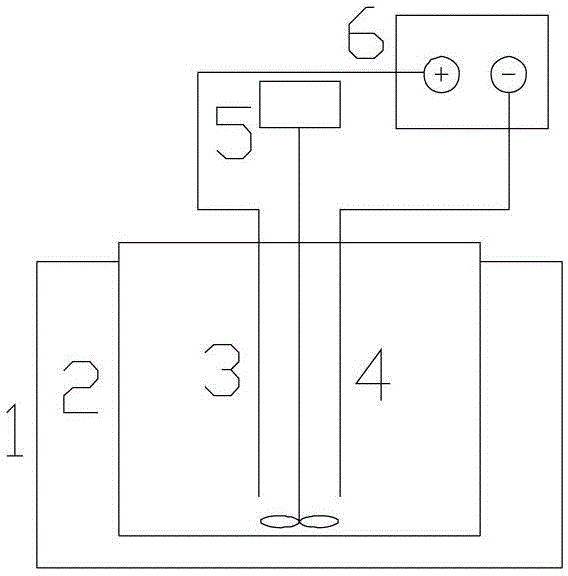Method for treating desulfurization wastewater by electrolysis
A technology for desulfurization wastewater and electrolysis treatment, which is applied in chemical instruments and methods, water/sewage multi-stage treatment, water/sludge/sewage treatment, etc. The effect of reducing and saving the cost of purchasing medicines
- Summary
- Abstract
- Description
- Claims
- Application Information
AI Technical Summary
Problems solved by technology
Method used
Image
Examples
Embodiment 1
[0050] Take 800ml of calcium carbide slag-gypsum desulfurization wastewater and place it in an electrolytic cell with a volume of 1050ml. The ruthenium-based coated titanium electrode is used as the anode, and the size of the ruthenium-based coated titanium electrode is 120mm*50mm*1mm. Customized by Industry Co., Ltd., the stainless steel plate is used as the cathode, stirred with a stirrer, heated and energized for electrolysis, and electrolyzed while stirring. Then add polyacrylamide to the effluent of electrolytic treatment at 8 mg / L for flocculation, and measure the pollution indicators of the effluent.
[0051] Electrolysis reaction process parameters: electrode water ratio 1:16, current density 0.75mA / cm 2 , the distance between the plates is 15mm, and the electrolysis temperature is 30°C. The stirring intensity is 250r / min, the electrolytic reaction time is 60min, and the power consumption is 0.27kwh / t.
[0052] The experimental results are as follows:
[0053]
...
Embodiment 2
[0056] Take 800ml of white mud-gypsum desulfurization wastewater and place it in an electrolytic cell with a volume of 1050ml. The ruthenium-based coated titanium electrode is used as the anode. The size of the ruthenium-based coated titanium electrode is 120mm*50mm*1mm. Customized by Industry Co., Ltd., the stainless steel plate is used as the cathode, stirred with a stirrer, heated and energized for electrolysis, and electrolyzed while stirring. Then add polyacrylamide to 10 mg / L of electrolytic treatment effluent for flocculation, and measure the pollution indicators of effluent.
[0057] Electrolysis reaction process parameters: electrode water ratio 1:16, current density 1.0mA / cm 2 , the distance between the plates is 10mm, and the electrolysis temperature is 40°C. The stirring intensity is 250r / min, the electrolytic reaction time is 60min, and the power consumption is 0.36kwh / t.
[0058] The experimental results are as follows:
[0059]
[0060]
[0061] It can ...
Embodiment 3
[0063] Take 800ml of another white mud-gypsum method desulfurization wastewater and place it in an electrolytic cell with a volume of 1050ml. The ruthenium-based coated titanium electrode is used as the anode. The size of the ruthenium-based coated titanium electrode is 120mm*50mm*1mm. Customized by Xin Titanium Industry Co., Ltd., the stainless steel plate is used as the cathode. Stir with a stirrer and heat and energize for electrolysis. Electrolyze while stirring. Then add polyacrylamide to the effluent of electrolytic treatment at 9 mg / L for flocculation, and measure the pollution indicators of the effluent.
[0064] Electrolysis reaction process parameters: electrode water ratio 1:8, current density 2.0mA / cm 2 , the distance between the plates is 20mm, and the electrolysis temperature is 25°C. The stirring intensity is 400r / min, the electrolytic reaction time is 80min, and the power consumption is 0.72kwh / t.
[0065] The experimental results are as follows:
[0066] ...
PUM
 Login to View More
Login to View More Abstract
Description
Claims
Application Information
 Login to View More
Login to View More - R&D
- Intellectual Property
- Life Sciences
- Materials
- Tech Scout
- Unparalleled Data Quality
- Higher Quality Content
- 60% Fewer Hallucinations
Browse by: Latest US Patents, China's latest patents, Technical Efficacy Thesaurus, Application Domain, Technology Topic, Popular Technical Reports.
© 2025 PatSnap. All rights reserved.Legal|Privacy policy|Modern Slavery Act Transparency Statement|Sitemap|About US| Contact US: help@patsnap.com



